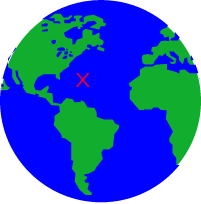Features of SeaMarks
Manual
To see all the capabilities of the program, you can download a PDF version of the manual here:
Click Here to Download version 10.2 manual (5.5 Mbytes)
What does the SeaMarks program do?
This program helps fishermen organize their GPS and Loran fishing spot navigation data accumulated over many years and many trips. With it, you can load your GPS with new data and print a new book of waypoints whenever you need to. It has routines for organizing, displaying, printing, plotting, and planning that will make your wealth of waypoints work better for you. Some of the features of the program are:
•Conversion – The program can convert waypoints (readings) from Loran TDs including obsolete A and C chains to Lat/Lon (GPS) and can convert GPS waypoints to Loran TDs. You can precision calibrate the conversions for the highest possible accuracy. Calibration uses your local knowledge to adjust the correction factors for best results.
•GPS Interfacing – Upload and Download the waypoints stored in a variety of GPS units via memory card transfer or cable connection. Handles Eagle, Furuno, Garmin, Hondex, Koden, Lowrance, Navman, NorthStar, Raymarine, Raytheon, Samyung, Sitex, Simrad, and Standard Horizon. It can handle the C-Map proprietary format used by several GPS models. Requires a suitable memory card reader for your PC or a cable (not supplied) connecting your GPS to the PC. This capability allows you to move waypoints between GPS brands and models. So, when you buy a new GPS, you can move all your waypoints to the new one and have a hard copy of the data in the GPS. You can also synchronize waypoints between multiple GPSs of different brands.
•Waypoint transfers – You can do Furuno to Garmin waypoint transfers, Lowrance to Raymarine waypoint transfers, NorthStar to Simrad waypoint transfers, and many other combinations. This includes, in many cases, routes transfers but not tracks transfers.
•Organizing – You can rearrange the data by sorting waypoints on any field. Double clicking on a spreadsheet column header will sort the file by that field. An advanced sorting menu is also available for more complex sorting.
•Display – by list or chart – Displays file data on the screen in list (spreadsheet) form with your choice of Lat/Lon, Loran TDs, and Range/Bearing. Also displays the file data graphically on the screen as charts with selectable Lat/Lon lines, Loran lines, range and bearing lines, waypoints, and a coastline. You can display or print on NOAA charts encoded in the BSB/KAP and NOS/GEO formats. The display is designed to efficiently use the whole screen to give you the most data at one time, (but you can shrink it). You can also display your waypoints, routes and tracks on Google Earth by exporting a KML file.
•Editing – Managing your data on the spreadsheet by all the usual spreadsheet techniques.
•Printing – Print a book to take out with you. You can specify which data fields to print and in what order on a printed list. You can also print maps and charts along with a list of the waypoints that fall within the borders of the map. If you have downloaded or uploaded a file from or to your GPS, you can print a list and charts that match what is in the GPS.
•Mapping – You can create a list of maps of specific areas that you want to print every time you re-work your book. Maps can be made for any size area and with or without Loran or Lat/Lon lines. Maps are saved as map files for ready retrieval. Maps can be printed in batches for convenience and can be either landscape or portrait orientation.
•Plan Trips/Routes – You can plan trips or routes by selecting waypoints from the file. The Trip Plan shows the range and bearing from each waypoint to the next and can be saved as a file and/or printed. Using the trip planner you can create a route and upload it to some GPSs.
•Search/Replace – Rapidly find waypoints by key words, phrases, or numbers. Do a global search and replace.
•Split/Combine/Merge Files – Files can be split along Lat/Lon, Loran, or Range/Bearing boundaries. Large files can be split into smaller files or small files can be combined or merged into larger files.
•Remove or Merge Duplicates – Identifies duplicate and near duplicate waypoints so that they may be combined or eliminated.
•Track Plotting – If you connect the computer to the GPS, you can plot your present position on the big screen and see where you are and your track. Requires a NMEA 183 cable connecting your GPS to the PC. Note, this does not seem to work in Windows 11 and has issues in Windows 10.
•Storage – Stores waypoints, routes, or tracks in files of up to 100,000 points. If you have a file to import that has more, it can be split into imports of 100,000 points. Each waypoint includes fields for Name, Latitude and Longitude, Loran TDs, Rating, Description, Depth, Date Code, Comments, Icon, Group, a symbol and a color.
last modified 10/23/2023
Operating System Compatibility
PC
The SeaMarks program is for Windows 98 through Windows 11 and requires at least 70 MB of disk space for the minimum installation and as much as 400 MB more with charts.
MAC, LINUX, and Chrome OS
You could use Parallels or Dual Booting to run this Windows program. It once ran under CodeWeavers’ Crossover, but lately it seems not to. You would have to get an older version of Crossover and also get a non-boxed version of SeaMarks to install it.
